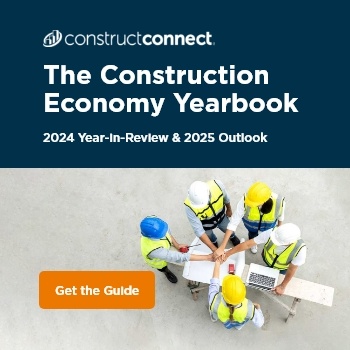

By: Michael Guckes, Chief Economist on September 23, 2024
Is the Fed too Late to Stem the Erosion in 2024 Spending?
There are many ways to measure how the construction industry changes over time. Year-to-date (YTD) figures are helpful because they provide an evolving picture of what to expect by year-end. With only four months remaining in this calendar year, current year-to-date measures, comparing the first eight months of 2024 against the same months from 2023, are already providing a keen sense of where 2024 will likely end.
For total construction, which sums residential, nonresidential building, and heavy engineering, YTD starts activity is presently down 2.4% from a year ago. Given the few months remaining in this calendar year and current conditions, even aggressive interest rate cuts designed to reignite economic and construction growth might not be enough to turn around this year’s lackluster results.
The year started off with residential and heavy engineering gains more than offsetting underwhelming nonresidential building activity. On net, total construction reported 3% to 5% YTD gains throughout most of the first half of the year. Beginning with June, total construction growth fell below 2% for the first time as slowing residential growth and a worsening contraction in nonresidential spending pulled overall results lower. Since then, only heavy engineering spending has reported positive YTD growth while spending in both residential and nonresidential construction has experienced an accelerating contraction.

Federal Funds rate in orange, projected rate in blue.
Through August, total construction starts spending is $15 billion lower than in the same months of 2023. It is well documented that interest rate changes impact economic activity with a lag, as companies and individuals take time to adjust and respond to higher financing costs and their ensuing impact on cashflows and returns on investments. Because home financing is highly dependent on borrowing it is also one of | the most rate sensitive segments of construction.
In 2022, as the Federal Reserve began hiking the Fed Funds Rate from 0% to what would eventually be over 5%, total monthly residential construction starts spending fell from a strong $38.6 billion in April 2022 to a multi-year low of $22.2 billion by February of 2023.
Now that the Federal Reserve cut rates, the anticipation should be for residential spending to provide early indications of a greater construction spending rebound. Under a scenario in which residential construction quickly rebounds back to 2021 levels, this would anticipate a $60-80 billion annualized boost to total construction. The possibility that $15 billion of this recovery might happen in 4Q2024 and unwind the present contraction may be a long shot. Regardless, it would certainly provide a solid base for a rebound in 2025.
This article originally appeared in the ConstructConnect September 2024 edition of The Construction Economy Snapshot.
About ConstructConnect
At ConstructConnect, our software solutions provide the information that construction professionals need to start every project on a solid foundation. For more than 100 years, our keen insights and market intelligence have empowered commercial firms, building product manufacturers, trade contractors, and architects to make data-driven decisions, streamline preconstruction workflows, and maximize their productivity. Our newest offerings—including our comprehensive, AI-assisted software—help our clients find, bid on, and win more projects.
ConstructConnect operates as a business unit of Roper Technologies (Nasdaq: ROP), a constituent of the Nasdaq 100, S&P 500, and Fortune 1000.
For more information, visit constructconnect.com.
About Michael Guckes, Chief Economist
Michael Guckes is regularly featured as an economics thought leader in national media, including USA Today, Construction Dive, and Marketplace from APM. He started in construction economics as a leading economist for the Ohio Department of Transportation. He then transitioned to manufacturing economics, where he served five years as the chief economist for Gardner Business Media. He covered all forms of manufacturing, from traditional metalworking to advanced composites fabrication. In 2022, Michael joined ConstructConnect's economics team, shifting his focus to the commercial construction market. He received his bachelor’s degree in economics and political science from Kenyon College and his MBA from the Ohio State University.


 Sign In
Sign In
